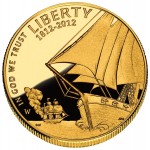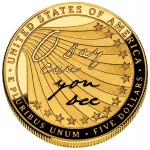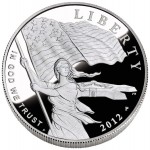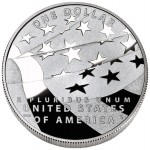Dec 15, 2012 | Baltimore, celebration, coins, commemorative, gold, silver, US Mint, video
 As we come down to the home stretch of the 2012 products, let me put in a word for the 2012 Star-Spangled Banner Commemorative Coins. Proceeds from the sale of these coins ($35 for the gold coin and $10 for the silver dollar) goes to the Maryland War of 1812 Bicentennial Commission to support their bicentennial activities, educational outreach, and preservation and improvement of the sites and structures related to the War of 1812, a war that has been called our second war for independence.
As we come down to the home stretch of the 2012 products, let me put in a word for the 2012 Star-Spangled Banner Commemorative Coins. Proceeds from the sale of these coins ($35 for the gold coin and $10 for the silver dollar) goes to the Maryland War of 1812 Bicentennial Commission to support their bicentennial activities, educational outreach, and preservation and improvement of the sites and structures related to the War of 1812, a war that has been called our second war for independence.
The design of the 2012 Star-Spangled Banner commemorative coins enhance the depiction of liberty and the fight for freedom that should be the hallmark of U.S. coin designs. The gold coin features a naval battle scene representing the victory in Baltimore Harbor over the Royal Navy in defending Fort McHenry and the reverse has the first words of Francis Scott Key’s poem, “The Defence of Fort McHenry.”
While the gold coin is a nice design, the design of the silver coin is even better. The obverse depicts Lady Liberty waving the 15-star, 15-stripe Star-Spangled Banner flag with Fort McHenry in the background. It is a powerful image representing one of the best designs representing freedom and liberty. The reverse is a modern 50-star flag waving. Images (included below) does not do this coin justice. You have to see this coin in hand to appreciate the design.
The last day to
purchase the Star-Spangled Banner Commemorative Coin will be on Monday, December 17, 2012 at 5:00 p.m. Eastern Standard Time.
It is always fascinating to see how the U.S. Mint works behind the scenes and hear from the designers and engravers. Philadelphia’s WPVI-TV went to the Philadelphia Mint to see how the 2012 Star-Spangled Banner commemorative coins are made. Here is their report:
In related news, it was announced that the Navy’s heralded Blue Angels will perform in Baltimore for the finale of the War of 1812 commemoration September 12-13, 2014. The Blue Angles will appear during the Star-Spangled Spectacular that will be held September 6-14, 2014 in Baltimore.
Buying the coins will not only add a beautiful coin to your collection but will help support the celebrations of the bicentennial of these important events in United States history. I bought the silver proof coin at Fort McHenry during the launch event.
The Coins:
Scott’s coin:
Credits
- Logo courtesy of the Maryland War of 1812 Bicentennial Commission.
- Video courtesy of WPVI-TV, Philadelphia.
- Coin images courtesy of the U.S. Mint.
- Image of Scott’s coin is owned by the author and covered under CC BY-NC-ND 3.0 license.
Oct 28, 2012 | coins, gold, grading
Professional Coin Grading Service announced that they certified their 25 Millionth coin. The coin is a rare 1871 (Meiji 4) 10 Yen With Border on the Reverse variety. It was among a group of 33 coins recently submitted by a PCGS Collectors Club member in Toyko. On October 24, 2012 it was certified PCGS Secure Plus™ MS65.
As a gift of appreciation to mark the milestone submission, PCGS is awarding the Japanese collector a Saint-Gaudens Double Eagle gold coin graded PCGS Secure Plus MS65 and valued today at $2,500.
The 1871 10 Yen is an important coin in Japanese numismatic history, according to PCGS. During the fourth year of the reign of Emperor Meiji, Japan adopted a gold standard under the New Currency Act of 1871, and it marked the start of the modern era of Japanese decimal coinage.
The 1871 10 Yen contains 16.6 grams of .900 fine gold, and 1,867,032 of the coins were minted that first year. The obverse design features a dragon and a pearl representing the sun. The reverse includes a mirror, sunburst and military banners with a raised line border around some of the design elements.
PCGS estimates the value of this particular coin at $6,000 or more.
Congratulations to PCGS on this milestone!
Image courtesy of PCGS.
Oct 27, 2012 | auction, Carson City, coins, gold, GSA, silver, tokens
How many of you look at the online auctions from the auction houses dedicated to numismatics and feel intimidated?
I can see quite a few virtual hands raised. You probably like coins shows but find the large crowds at some of those shows may also be intimidating. After all, you’re a collector, not an investor or a professional. Sometimes, you can find gems at smaller shows and even smaller auctions.
This is why I was intrigued by an auction notice sent by Stephenson’s Auctioneers and Appraisers from Southampton (Bucks County), Pennsylvania. Judging by their website, Stephenson’s is a local auction company that mainly serves buyers and sellers in its region with and probably has some clientele outside the eastern Pennsylvania area where they are located.
The nice thing about these local auction houses is that they are more accessible than the big houses and they usually have items that are affordable to the average collector. While high-end auctions are fun, if you are buying for yourself, you may not be the type looking to spend six-figures or higher on a coin.
If that is the case and you are in the Bucks County, Pennsylvania area on Friday, November 2, you may want to stop by Stephenson’s and check out their more than 200-lot coin auction that may include “some nice last-minute surprises.”
These are estate auction from the eastern Pennsylvania area. According to the information sent to me, the auction includes a wealth of Morgan silver dollars will be offered, with no fewer than 15 lots comprised of three Morgans each. An uncirculated 1882 Carson City Morgan silver dollar is one of the highlights, and another early example is a trade silver dollar dated 1877. Other antique American coins include Capped Bust half dollars from 1809 and 1838; an 1806 Draped Bust half dollar, and a Seated Liberty half dollar from 1843.
The auction includes two gold pieces. One is a 1914 Indian Head quarter eagle ($2½) and a 1917 $1 gold coin commemorating the slain U.S. President William McKinley.
There are many collectors’ books of coins, including a Washington quarter book (1932-1945) with 24 silver quarters, a Liberty Head nickel book (1883-1912) with 25 nickels, a Standing Liberty book with 10 silver half dollars, a Mercury dime book with 74 silver dimes, including 1921 and 1921-D; and a book consisting of 60 Buffalo nickels. Also included are a Walking Liberty half dollar book with 14 half dollars, a Barber dime book, Roosevelt dime book and Kennedy half dollar book with 59 Kennedy halves, including three 1964 and nine 1965 through 1970 coins. Flying Eagle and Indian Head penny sets will be available, as well as many other books, too numerous to mention.
Desirable non-monetary gold and silver items with both intrinsic and historical value include a boxed set of three 24K gold over .999 silver ingots commemorating the 1973 Triple Crown Winner Secretariat, and a framed sterling silver set titled “The Official Bicentennial Medals of the Thirteen Original States.”
Other lots of interest include two California Gold tokens (1852 and 1853) and an 1860 $5 note issued by the Miners and Planters Bank of North Carolina. Fractional currency, and U.S. Prestige and Olympic Prestige sets.
Auction will be held on Friday, November 2, 2012 at Stephenson’s gallery located at 1005 Industrial Blvd., Southampton, PA 18966. Auction preview is on the auction day from 2-4 p.m. The auction starts at 4 p.m.
For additional information, call Cindy Stephenson at 215-322-6182 or e-mail info@stephensonsauction.com. There will be no Internet bidding for this sale; it is exclusively for gallery, phone and absentee bidders. Visit Stephenson’s online at www.stephensonsauction.com.
If you are in the area, go and have some fun. Who knows, you may find something interesting to bid on!
Some of the items in this auction
-

-
1882 Carson City uncirculated Morgan silver dollar with original GSA box and paperwork. You do not see too many CC Morgans with the original box and paperwork!
-
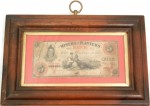
-
1860 $5 note, Miners and Planters Bank of North Carolina.
-

-
Three 24K gold over .999 silver ingots Commemorative of Secretariat.
-
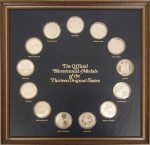
-
Thirteen sterling silver “Official Bicentennial Medals of the Thirteen Original States.”
-
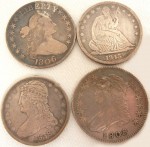
-
Early US coins, including 1809 and 1838 Capped Bust half dollars, 1806 Draped Bust silver dollar, and a, 1843 Seated Liberty half dollar.
-
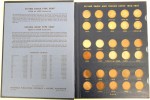
-
Flying Eagle and Indian Head Cent set in a Whitman Album
-
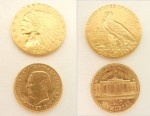
-
1914 Indian Head Quarter Eagle ($2½) gold coin and McKinley Commemorative “Dollar” gold piece.
-
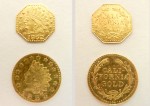
-
1852 and 1853 California Gold Rush tokens
All images courtesy of Stephenson’s Auctioneers.
Oct 12, 2012 | bullion, Federal Reserve, gold, history, review
Prior to the very entertaining Vice Presidential Debate, the National Geographic Channel aired a show titled “America’s Money Vault” that was part of their “Behind the Scenes” week. The show was hosted by Jake Ward, editor-in-chief of Popular Science magazine.
The show is centered around the Federal Reserve and primarily the operations of the Federal Reserve Bank of New York. After opening the show at Times Square, we are transported downtown to the New York Fed where they are accepting a deposit of over 1 ton of gold. Following an explanation that the New York Fed is the most trusted handler of gold in the world and has 25-percent of the world’s gold on deposit, we watch the transfer process.
As part of the transfer process, the cameras are brought into the vault and the viewers are show “walls” of gold bars. Unlike the images in the 1995 movie Die Hard: With a Vengeance, it appears that the vault that is more solid than the jail-like bars shown in the movie.
Ward visited with Federal Reserve Chairman Ben Bernanke to talk about the Fed’s roll in the markets. While in Washington Ward visits the Bureau of Engraving and Printing to show some of the process in currency printing. There was also a discussion with the United States Secret Service about anti-counterfeiting.
One of the more interesting visuals was when Ward visited the East Rutherford Operations Center (EROC), one of the New York Fed’s currency operations. Viewers were shown rows of currency and coins being stored on shelves throughout the building. And in a scene to warm my technical heart, the robotic inventory system was profiled.
According to NatGeo TV, the next time America’s Money Vault will air is on Thursday, October 18, 2012 at 4:00 PM Eastern Time. If you will be away at that time, it is worth setting the DVR (or VCR for those still going old school) to record this show.
Sep 8, 2012 | Carson City, cents, coins, errors, fun, gold, silver
I was reading the article “How to follow the money in rare-coin collecting” at MarketWatch.com about the basics of collecting rare coins when I noticed that it pointed to a page withe a slideshow, “The $1 million penny and 7 more famous coins.”
The list has only one “reasonably priced” coin—that is a coin that someone with a little means could afford. It lists the an 1850 Double Eagle at $13,000. That started me to think about the potential to actually owning a few rare collector coins with value and something more align with my tastes. After thinking about this I came up with a list of my “10 Most Desired Coins Within Reason.” In this case, I defined reason as not being so rare that it could only be bought with the help of a good dealer and would not require bidding on it at a once-in-a-lifetime auction. I also set a limit of $5,000 on the price of any coin. I know this may limit the inventory to lower grade for some coins, but those lower grades could give the coin character.
Mostly in denomination and date order, here are Scott’s 10 Most Desired Coins Within Reason:
- 1793 Flowing Hair Chain Cent with AMERI. in Legend is basically amongst the first legal tender coins produced by the U.S. Mint. I know that there was an earlier run of half-dismes, but they were not real production runs. If I am going to produce a list like this, I am going to pick the coin I like and break one of my rules because even at its lowest grade, the coin will probably cost more than $10,000.
- 1909-S Indian Head Cent in Mint State Red. Even though the 1908-S was the first Indian Head cent struck in San Francisco, I am choosing the rarer of the two S-mint Indian Heads in Mint State Red. Of course, this may also break my budget but it would be no fun otherwise.
- 1909-S VDB Lincoln Cent may not be the most expensive Lincoln Cent (the 1914 is), but it is the first of the iconic series and part of the controversy started because of the “V.D.B” initials on the reverse. Fortunately, I already own one graded as VF-30BN by NGC.
- 1955 Double Die Obverse Lincoln Cent is the coin that sparked the interest in error collecting. It is remarkable to think that one coin, a mistake, created a new segment of the hobby. For me, I already own one graded AU-58BN by NGC that I really like.
- 1937-D 3-Legged Buffalo is a very cool coin. Aside that the Buffalo Nickel is one of my favorite coin designs, there is something intriguing about the story behind this coin. Fortunately, the one I own was graded VF-25 by NGC and the last of the ones I already own on this list.
- 1917 Type 1 Standing Liberty Quarter is a compromise because the 1916 would be too expensive. In order to add a type 1 design (with breast exposed), the 1917 version is more reasonably priced in higher grades.
- 1921 Walking Liberty Half Dollar would be the coin I would point to on this list as being my favorite design. For me, only the Saint-Gaudens Double Eagle come close to Adolph Weinman’s design. It should not surprise anyone that Weinman was one of Saint Gaudens’ students. The 1921 half dollars were almost an afterthought as the U.S. Mint was rushing to produce silver dollars and the 1921 fits the criteria to buy one in higher grades.
- 1878-CC Morgan Dollar in the GSA Holder because it is interestingly historic. The Morgan Dollar was authorized by the Bland-Allison Act that required the Treasury Department to buy silver from western mines and put them into circulation as silver dollars. It was passed after the Coinage Act of 1873, sometimes referred to as the “Crime of ’73,” demonetized silver and set the standard for gold as the backing of the national currency. Not only do you get the collectible from a western state near a western mine, but the GSA Holder is from the historic sales of the 1970s after the GSA started pulling coins out of storage in buildings long forgotten.
- 1908 Indian Head Gold Half-Eagle because if you make a list like this, there has to be some gold on it. If I am going to do a gold coin, I want the only coin whose design is incuse to the coin. Bela Pratt Lyon’s incuse Indian Head design is unique and nicely available in its first year of mintage.
- 1907 No Motto Saint Gaudens Double Eagle because this list cannot be complete with the other of the two most iconic designs ever made for a circulating coin. Since 1907 is the first year, this is the most affordable of the three types made that year and is more available than the high-relief versions.
Do you have a similar list? Add it to the comments below.
Sep 5, 2012 | advice, gold, investment, news
Gold Buyers Beware: Experts Caution Coated Tribute Coins Are Not “Gold Coins”
 PNG Press Release: Temecula, California—With the price of gold recently increasing, people who want to invest in the precious metal should be cautious about the potential investment value of gold-plated “tribute coins,” according to the Professional Numismatists Guild (www.PNGdealers.com), a nonprofit organization composed of many of the country’s top rare coin and currency dealers.
PNG Press Release: Temecula, California—With the price of gold recently increasing, people who want to invest in the precious metal should be cautious about the potential investment value of gold-plated “tribute coins,” according to the Professional Numismatists Guild (www.PNGdealers.com), a nonprofit organization composed of many of the country’s top rare coin and currency dealers.
Frequently advertised on television, the tribute items are replicas of popular United States Mint gold bullion coins, but are privately produced and often contain only a tiny amount of gold.
“These tribute replicas may be fine souvenirs and mementos as inexpensive medallions, but should not be considered an actual precious metal investment because they have only a razor-thin coating of gold and virtually no secondary market value as gold. They’re also not a United States Mint product, so they’re not even U.S. legal tender coins even though their designs may be similar to actual U.S. coins,” cautioned Jeffrey Bernberg, PNG President.
“Some of the look-alike tribute ‘coins’ are advertised as containing 14 milligrams (mgs) of 24 karat gold. That equals a minuscule .00045 troy ounce of gold; less than one-thousandth of an ounce. So, if the price of gold is at $1,690 an ounce, then 14 milligrams would be equal to only about 76 cents worth of gold,” he explained.
The Professional Numismatists Guild was founded in 1955. PNG members must adhere to a Code of Ethics that prohibits use of high pressure sales tactics and misrepresentation of the value of items being sold. PNG members also must demonstrate knowledge, responsibility and integrity in their business dealings, and must agree to binding arbitration to settle unresolved disagreements over numismatic property. A complete list of PNG member-dealers can be found online at www.PNGdealers.com.
For a copy of the informative pamphlet, “What You Should Know Before You Buy Rare Coins,” or a printed directory of PNG member-dealers, send $1 to cover postage costs to: Robert Brueggeman, PNG Executive Director, 28441 Rancho California Rd., Suite 106, Temecula, CA 92590. Phone: (951) 587-8300. Email at info@PNGdealers.com, or visit the web site at www.PNGdealers.com.
Sep 4, 2012 | bullion, gold, markets, news, platinum
Unrest continues in the mining communites of South Africa as the National Union of Mineworkers (NUM) ups their efforts to calm the rank and file. The NUM, an ally of the ruling African Nationa Congress (ANC), have rejected calls to exploit the termoil for the benefit of the workers.
The strike has virtually shut down the Lonmin mine that supplies 19-percent of the platinum to the world.
Gold One is reporting that the wildcat strike that caused four injuries yesterday was open on Tuesday. However, the nearby Aurora mine also owned by Gold One remains closed.
Worker unrest is happening during the campaign for control of the ANC. Former youth leader Julius Malema has been travelling to the effected mines blaming President Jacob Zuma for anti-worker policies and accusing the NUM of partnering with the ANC not in the benefit of the workers.
Malema was expelled from the ANC for “ill discipline.”
Lonmin and Gold Fields stock, already depressed prior to current events, are down even further on the United States and South African markets. Trading on Gold Fields stock in South Africa has been halted on market trading rules.
Currently, gold and platinum prices are trading based on current economic conditions with futures looking at December delivery of these metals. An analyst interviewed for this story said that if the unrest continues, the futures prices will not be affected until late January or early February deliveries are traded—which could begin later in September.
The Coin Collectors Blog will continue to monitor the international reporting and market reaction for their effect on metals prices. Stay tuned!
Sep 3, 2012 | gold, markets, news, platinum

An unidentified mine worker sits on a rock at the Lonmin mine near Rustenburg.
Unrest continues as police used tear gas and rubber bullets to turn back a group of about 60 mineworkers at the Gold One mine at Modder East near Johannesburg who was blocking the roads and throwing rocks at vehicles trying to enter the mine area. Four miners were reported hospitalized by police actions.
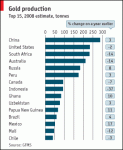 Fear of national mining disruption continues as strikes spread to gold mines in South Africa. Local business leaders are afraid that the strikes will hurt South African mines in the long term causing a ripple effect in the economy. South Africa is the world’s third leading producer of gold behind China and the United States.
Fear of national mining disruption continues as strikes spread to gold mines in South Africa. Local business leaders are afraid that the strikes will hurt South African mines in the long term causing a ripple effect in the economy. South Africa is the world’s third leading producer of gold behind China and the United States.
Market analysts have been reporting that since they see South Africa as an “investor-unfriendly” country that most investments are in exchange-traded funds (ETF) that helps balance the risks.
Gold futures for December delivery rose $9.60, or 0.6-percent, to $1,697.20 an ounce in electronic trading today. London Gold Fixing PM price was $1,691.50, up $5.50 from the AM fix or 0.3-percent. U.S. markets were closed on Monday for the Labor Day holiday.
AP Photo/Themba Hadebe of striker courtesy of IOL Business Report.
Gold Production graph courtesy of ZeroHedge.
Sep 2, 2012 | bullion, gold, news, platinum
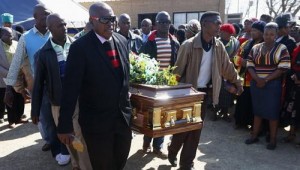
Mourners carry the casket of Andries Motlapula Ntsenyeho, one of the 34 striking platinum mineworkers shot dead at Lonmin’s Marikana mine, at his home town of Sasolburg in South Africa’s Free State province on Sept 1, 2012.
“The murder charge against the current 270 suspects, which was provisional anyway, will be formally withdrawn provisionally in court on their next court appearance,” acting national director of prosecutions Nomgcobo Jibo told a news conference.
The move to drop the charges occurred as funerals are being held for those killed during the strike.
Unrest continues in Marikana and other South African mining towns as police are being investigated after admitting to firing on striking mineworkers. Some of those officers are on administrative leave but no arrests have been made. This has put pressure on current president Jacob Zuma, who is seeking re-election this December.
Lonmin is the world’s third largest producer of platinum accounting for 12-percent of the world’s production. Lonmin’s primary market is the use of platinum in catalytic converters in cars.
The Marikana mine has been closed since the massacre and was set to re-open after this weekend’s funerals. There has been no report as to whether the wildcat sympathy strike at the KDC East mine owned by Gold Fields will allow that mine to open.
Weak demand has pushed down the market price of platinum leaving mining operators slimmer margins as costs have been rising. The price of platinum has risen only 8.3-percent ($117.00) since August 16, but only up 7.8-percent in 2012.
Gold closed at $1648.50 in London on Friday, down $17 from Thursday (0.7-percent). The price of gold closed at $1691.60 on the New York market, rising after Federal Reserve Chairman Ben Bernanke hinted that the Fed could introduce a “fresh, unconventional U.S. monetary policy stimulus will be implemented at some point.”
There have been no reports from market analysts as to how the South African unrest will effect metals prices.
Image courtesy of Reuters via The Sunday Times of Singapore
Sep 1, 2012 | gold, news, platinum
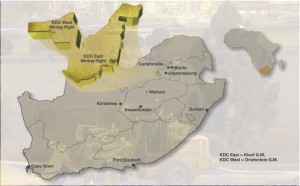
Location of the Gold Field’s Kloof-Driefontein Complex (KDC)
According to Gold Fields, KDC East produces 1,660 ounces of gold per day.
The Association of Mineworkers and Construction Union (AMCU) has said that they are not involved with the strike and claims the strike was caused by a dispute between National Union of Mineworkers (NUM) branches. AMCU is working with the South African government over the shooting deaths of 34 and wounding 78 striking minders by police at the Lonmin Platinum mine on August 16. The South African National Prosecuting Authority charged 270 miners with murder and attempted murder.

Striking platinum mineworkers gather for a report back on negotiations at Lonmin’s Marikana mine in South Africa’s North West Province, August 29, 2012.
NUM workers have been on strike since August 10, primarily in a dispute with their own union claiming that the union leaders are more interested in politics than the needs of the miners.
Lonmin reports that a 6.6 average attendance in all shafts of the mine following the shootings. The mine is located in the city of Rustenburg, northwest of Johannesburg.
London Gold Fixing closed at $1,648.50, down $9.25 from the morning price. Platinum closed at $1,517.00 up $9.00 from the morning price. Prices were posted prior to the statement issued by Gold Fields. London markets are open on September 3 while the United States markets will be closed for Labor Day.
Map of KDC courtesy of Gold Fields, Ltd.
Image of striking workers courtesy of Reuters/Mike Hutchings
 As we come down to the home stretch of the 2012 products, let me put in a word for the 2012 Star-Spangled Banner Commemorative Coins. Proceeds from the sale of these coins ($35 for the gold coin and $10 for the silver dollar) goes to the Maryland War of 1812 Bicentennial Commission to support their bicentennial activities, educational outreach, and preservation and improvement of the sites and structures related to the War of 1812, a war that has been called our second war for independence.
As we come down to the home stretch of the 2012 products, let me put in a word for the 2012 Star-Spangled Banner Commemorative Coins. Proceeds from the sale of these coins ($35 for the gold coin and $10 for the silver dollar) goes to the Maryland War of 1812 Bicentennial Commission to support their bicentennial activities, educational outreach, and preservation and improvement of the sites and structures related to the War of 1812, a war that has been called our second war for independence.